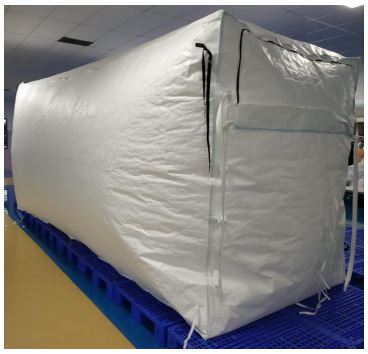Essential Guide to Choose the Best Shipping Container Liner
In today’s globalized world, efficient and secure bulk shipping is crucial. Container liners have emerged as a game-changer, offering a cost-effective and versatile solution for transporting dry bulk goods. But with various options available, selecting the best container liner for your specific needs can feel overwhelming.
This comprehensive guide will equip you with the knowledge to make informed decisions and choose the perfect container liner for your next shipment.
Demystifying Container Liners
A container liner, also known as a shipping container liner, is a large, flexible bag specifically designed to fit snugly inside a standard shipping container. Made from durable woven polypropylene (PP) or polyethylene (PE) fabrics, container liners provide an additional layer of protection for your cargo during transit.
Features of Container Liners:

- Sizes: Container liners come in various sizes to fit standard 20-foot and 40-foot shipping containers.
- Strength: They are constructed from high-strength materials to withstand the rigors of long-distance transport.
- Discharge and Filling Systems: Many container liners feature built-in discharge spouts or valves for efficient loading and unloading.
- Customization: Some manufacturers offer customization options like specific liner materials, discharge configurations, and temperature resistance.
Benefits of Shipping Container Liners
Container liners offer a multitude of advantages over traditional bulk shipping methods like loose bags or drums. Here’s why they deserve a spot in your shipping strategy:
- Cost-Effectiveness: Container liners maximize space utilization within a container, allowing you to ship more cargo per container and reducing overall shipping costs.
- Enhanced Protection: They create a barrier between your cargo and the container walls, safeguarding your products from contamination, moisture, and physical damage.
- Streamlined Loading and Unloading: Container liners facilitate faster and easier loading and unloading compared to loose bags, minimizing labor costs and turnaround time.
- Reduced Risk of Spillage: With secure filling and discharge systems, container liners minimize the risk of spillage and product loss during handling.
- Versatility: Container liners can accommodate a wide range of dry bulk goods, making them suitable for various industries.
- Environmentally Friendly: Some container liners are recyclable, promoting sustainability in your supply chain.
Choosing the Perfect Container Liner: Key Considerations
Now that you understand the benefits, let’s explore the crucial factors to consider when selecting the best shipping container liner for your needs:
- Material Selection:
-
- Woven Polypropylene (PP): This is the most common choice for dry, free-flowing products. It offers excellent strength, durability, and cost-effectiveness.
- Polyethylene (PE): PE liners provide additional moisture resistance and are suitable for products sensitive to moisture absorption.
- Size and Capacity:
-
- Ensure the container liner accurately fits your chosen container size (20ft or 40ft) and offers sufficient capacity for your specific cargo volume.
- Discharge and Filling Systems:
-
- Choose a liner with discharge options (spout location & type) that align with your unloading facilities (top or bottom discharge).
- Additional Features:
-
- Consider if you require special features like temperature resistance, anti-static properties, or food-grade compatibility based on your cargo needs.
- Quality and Certification:
-
- Opt for container liners from reputable manufacturers who prioritize quality control and adhere to relevant industry standards.
Conclusion
By utilizing this guide and carefully considering these factors, you can select the ideal container liner to optimize your bulk shipping operations. Container liners offer a cost-effective, secure, and efficient solution, ultimately ensuring the safe and timely arrival of your cargo at its destination.
Ready to explore the world of container liners? Contact us today to discuss your specific requirements and find the perfect liner for your next shipment!
FAQ
-
Why Container Liners?
According to the Network for Transport and Environment, maritime shipping is the world’s most carbon-efficient form of transporting goods more efficiently than road, rail and air. Despite this fact, many companies are still looking for other innovative ways to reduce carbon footprint. Container Liners are that solution. Dry Bulk Container Liner is one of the most cost-effective means of bulk packaging. The main advantage is that maximum payload with minimum residue on discharge.
-
Why Container Liners from Rishi?
Rishi FIBC manufactures over 10 million FIBCs and 1.50 million Dry Bulk Container Liners per annum. We have qualified professionals in the Container Liner technical sales team and a global network of agents and distributors who are Dry Bulk Container Liner professionals. Today Rishi FIBC is equipped with Asia’s most modern and fully integrated facility for manufacturing woven PP, HDPE and Blown film (PE, EVOH) container liners.
-
What materials are container liners made of?
Container liners can be made from various materials, including woven polypropylene (PP) or polyethylene (PE). The choice of material depends on factors such as cargo type, handling requirements, and cost-effectiveness.







